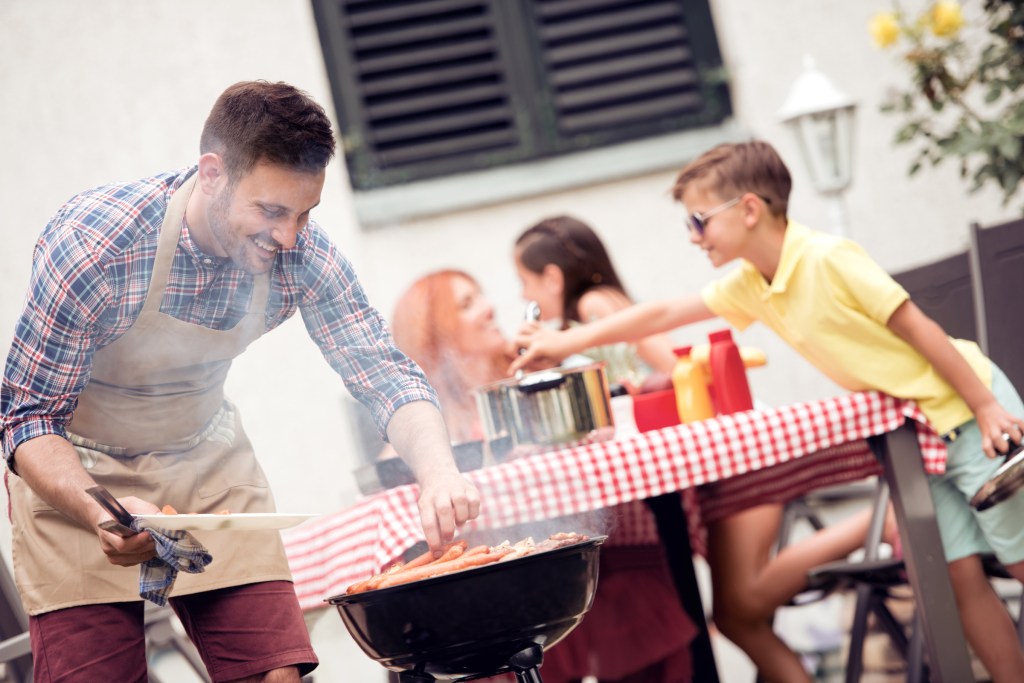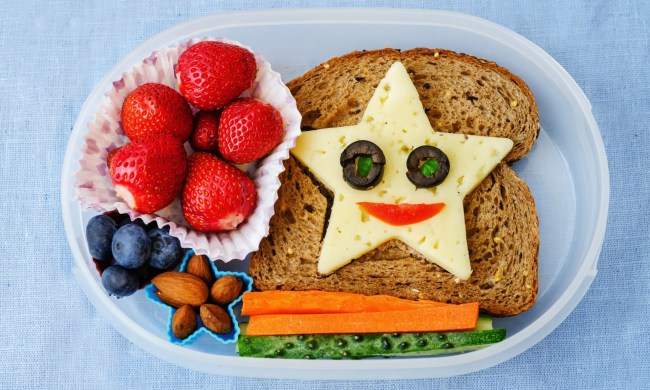Keeping children safe around the grill is easier said than done, but it’s still so, so important. The wrong move, a lack of attention, curious fingers getting in the way — it can all lead to devastating injuries. But don’t feel like you should never fire up the grill again even if you have a little one in the house. You can safely grill, even with your child around, when you follow our safe grilling tips. Here are 7 easy tips and tricks to teach you how to keep your kids safe around the grill — no matter what their age.
Safe Grilling Tips
Place your grill in the right spot
Picking a spot for your grill requires a bit of thought. You’ll want to avoid simply setting up shop in that one free corner of your deck, or in that spot on your patio nearest to the kitchen window.
Look for a grill location that’s safely away from any house siding, wooden deck railings and overhanging tree limbs. You’ll also want to place the grill a good few feet away from any high traffic areas where your kids are likely to walk or run, as well as away from places your children are likely to be playing. Once you have a spot picked out, communicate to your children that they should not approach the grill, even when not in use.
Keep your grilling gear out of reach
Five-year-olds, toddlers and even older kids are all too apt to pick up and examine just about anything within reach. Be sure to keep all of your grilling gear well out of their arms’ length. This includes not only things like lighter fluid and lighters and matches, but also grilling tongs, grill brushes and other items that you might be using while the grill is heated up. What could look like an innocent, shiny utensil to them could actually be a burning-hot piece of metal that was just removed from the flame — and that’s something you definitely don’t want them wrapping their tiny fingers around.
Pay attention — always
Not only is it important to pay attention to your grill for the sake of your food, but leaving a grill unattended — even for just a few seconds — is a big safety hazard. You never know when a burger or steak may drip a few dollops of grease into your flame, resulting in a fire much larger than you intended. You’ll want to be around to mitigate these risks. So, if the grill is on, make sure an adult is always there, watching, even if you haven’t started cooking anything yet. An open flame is something that should be watched.
Keep your grill clean
One of the easiest ways to reduce the chances of one of those above-discussed flame ups, and thereby reduce the chance of your child being harmed if one occurs is to simply keep your grill clean.
Beyond using a grill brush to scrape your grates after every grill use, also remember to empty all of the trays below your grill grate. Grease, fat and food particles can build up and they can easily catch fire when you least expect it. If you don’t care for cleaning your grill on such a regular basis, eliminate some of the build-up by cooking on aluminum foil rather than directly on your grill’s grates.
Look out for non-fire-related hazards
There are a lot of other hazards that come with grilling that aren’t related to fire or burns. Your barbecue grill is covered in hard metal pieces and rough edges that, if your child falls the right way, could scratch or cut your child. And while minor cuts and bruises aren’t as big a worry as, say, third-degree burns, you still don’t want them to happen.
To provide at least a little bit of extra protection, you can cover these edges with masking tape (so long as they’re not a part of the grill that’s exposed to heat).
Educate your child about the grill and its dangers
Of course, education is key to keeping your child safe from any danger. Let them know about the various dangers of grilling and the fire hazard your grill poses, even if they’re just a toddler and they might not be able to understand the fine details. If you have an older child, make sure it’s known that you’re not telling them so that they can then use the grill safely (as some children might assume) — instead, make it clear you’re explaining to them the dangers of the grill, so that they continue to steer clear of it.

Make sure there’s something to keep the kids’ attention while you’re at the grill
Lastly, an easy way to ensure your child’s or children’s safety when you’re at the grill? Simply make sure they have something else to do, so that they’re not bored, wandering around your grill space, asking you questions or looking for attention. Yard games, play equipment or even just a coloring book at the patio table — if it keeps them away from the grill, but still within sight, it’s a good option. Better yet, have an adult present who’s specifically dedicated to keeping an eye on the kids, just like you would have an adult present to do so while your kids are in the swimming pool.
Have fun this summer — but do it safely
Summer is filled with opportunities for family fun, but you want to make sure that the entire family stays safe the entire season. A few extra precautions when it comes to grilling can ensure that no one suffers unnecessary injuries at or around the grill, so everyone can have an amazing time. Whether you’re watching your young children or another parent’s kids, grill safety is something to be taken seriously.
Ready to get grilling? Just remember to put your grill somewhere safe, keep your grill clean, keep your grilling gear out of reach and pay attention to the kids, and you should do just fine.


